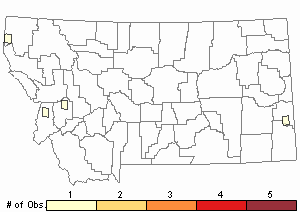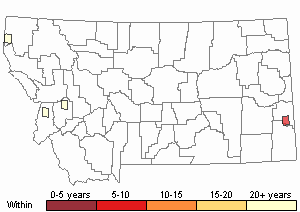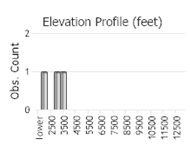View in other NatureServe Network Field Guides
NatureServe
Montana
Utah
Wyoming
Idaho
Wisconsin
British Columbia
South Carolina
Yukon
California
New York
A Lime Moss - Didymodon brachyphyllus
Other Names:
A Didymodon Moss,
Didymodon vinealis var. brachyphyllus
General Description
Plant: Acrocarpous.Green to dark green, often with reddish tint. Stems to 1 cm with central strand (FNA 2007).
Leaf: When dry, leaves usually appressed, spreading yet stiff with no keel when wet. Ovate to ovate-lanceolate, 0.7 to 1 mm. Margins slightly recurved to near leaf tip, entire, often cucullate (resembling a monk's hood) near apex. Apex broadly acute, frequently with 1-3 celled apiculus. Costa percurrent, occasionally slightly excurrent (FNA 2007).
Leaf Cells: Distal laminal cells 1:1, almost smooth or with simple or 2-fid papillae, 2-3 per lumen (cell cavity within cell wall). Costal cells quadrate to short-rectangular, 4(-6) cells across at mid leaf, guide cells 1(-2)-layered. Basal laminal cells quadrate to short-rectangular, thin-walled. Distal leaf margins 1-layered or sometimes 2-layered (FNA 2007).
Phenology
Capsules mature spring through fall (FNA 2007).
Diagnostic Characteristics
May be confused with D. vinealis. Unlike that species, however, D. brachyphyllus never has lanceolate leaves (FNA 2007).
Range Comments
Greenland; Canada: BC; USA: AK, AZ, CA, CO, ID, MT, NM, OR, UT, WA; Mexico; Atlantic Islands (Iceland); Antarctica (FNA 2007; McIntosh 1989). In Montana, known from Granite, Lincoln, and Ravalli Counties (Elliott 2016).
Observations in Montana Natural Heritage Program Database
Number of Observations: 4
(Click on the following maps and charts to see full sized version)
Map Help and Descriptions
Relative Density

Recency



 (Observations spanning multiple months or years are excluded from time charts)
(Observations spanning multiple months or years are excluded from time charts)
Habitat
On dry soil and rock, including volcanic ash outcrops and mortar (Elliott 2016), limestone, sandstone cliffs, dry grassland, near streams and springs. Low to high elevations (250-7500 feet) (FNA 2007).
Reproductive Characteristics
Dioicous. Seta 0.8-1 cm. Capsule 1.5-2.5 mm (FNA 2007).
Axillary gemmae provide asexual reproduction (FNA 2007).
Stewardship Responsibility
References
- Literature Cited AboveLegend:
 View Online Publication
View Online Publication Elliott, J.C. and A.K. Pipp. 2018. A Checklist of Montana Mosses (1880-2018). Updated 3 January, 2020. Montana Natural Heritage Program, Helena, Montana. 73 pp.
Elliott, J.C. and A.K. Pipp. 2018. A Checklist of Montana Mosses (1880-2018). Updated 3 January, 2020. Montana Natural Heritage Program, Helena, Montana. 73 pp. Flora of North America Editorial Committee, eds. 2007. Flora of North America North of Mexico. Volume 27. Bryophytes: Mosses, Part 1. Oxford University Press, Inc., NY. xxi + 713 pp.
Flora of North America Editorial Committee, eds. 2007. Flora of North America North of Mexico. Volume 27. Bryophytes: Mosses, Part 1. Oxford University Press, Inc., NY. xxi + 713 pp. McIntosh, T.T. 1989. Bryophyte Records from the Semiarid Steppe of Northwestern North America, Including Four Species New to North America. The Bryologist 92(3):356-362.
McIntosh, T.T. 1989. Bryophyte Records from the Semiarid Steppe of Northwestern North America, Including Four Species New to North America. The Bryologist 92(3):356-362.
- Additional ReferencesLegend:
 View Online Publication
View Online Publication
Do you know of a citation we're missing? Elliot, J. C. 1993. Second checklist of Montana mosses. Unpublished report. U.S. Forest Service, Region 1. Missoula, MT. 45 pp.
Elliot, J. C. 1993. Second checklist of Montana mosses. Unpublished report. U.S. Forest Service, Region 1. Missoula, MT. 45 pp. Lawton, E. 1971. Keys for the Identification of the Mosses on the Pacific Northwest. Reprinted from 'Moss Flora of the Pacific Northwest'. Published as Supplement No. 2 of the Journal of the Hattori Botanical Laboratory. Nichinan, Miyazaki, Japan. 66 pp.
Lawton, E. 1971. Keys for the Identification of the Mosses on the Pacific Northwest. Reprinted from 'Moss Flora of the Pacific Northwest'. Published as Supplement No. 2 of the Journal of the Hattori Botanical Laboratory. Nichinan, Miyazaki, Japan. 66 pp. Lawton, E. 1971. Moss Flora of the Pacific Northwest. Hattori Botanical Laboratory. Japan: Yamabuki-cho, Shinjuku-ku, Tokyo. 362 pages plus appendices.
Lawton, E. 1971. Moss Flora of the Pacific Northwest. Hattori Botanical Laboratory. Japan: Yamabuki-cho, Shinjuku-ku, Tokyo. 362 pages plus appendices.
- Web Search Engines for Articles on "A Lime Moss"





